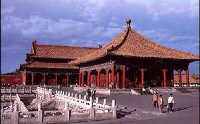Baohedian (Hall of Preserving Harmony)

Baohedian, the Hall of Preserving Harmony, sits on the northern end of the three-tiered marble terrace, similar in style but a bit smaller than the Hall of Supreme Harmony and larger than the Hall of Central Harmony. It was first built in 1420, rebuilt in 1625 and renovated in 1765. In the Ming Dynasty, emperors usually change their clothes here before ceremonies of conferring empress or crown prince. In the Qing Dynasty, imperial banquets usually would be given here. To celebrate a princess's marriage, emperors would invite high officials, the bridegroom and his father, and their relatives who served the imperial government to a banquet. Every year, on New Year's Eve, banquets would be held to feast and honor margraves, Mongol princes and civil and military officials.
In 1789, middle of the Qing Dynasty, Emperor Qianlong removed Palace Examination, the highest level and final stage of the nationwide imperial examination system, from the Hall of Supreme Harmony to this hall. Emperors would read papers of the top ten candidates to honor them.
In rainy days, visitors will have chance to see the spectacular scene of a thousand dragons draining water. There are 1,412 marble stone dragon heads under the columns of the three-tiered terrace on which the three main halls are seated. Chinese artisans smartly combined drainage system with architectural art. Once you get a chance to the Forbidden City, please notice the holes in dragons' mouths. However, the ones in the corners have no holes.
Huge Stone Carving

Behind the Hall of Preserving Harmony, in the middle of the stairway, is a huge piece of marble carving of nine dragons playing with pearls. It is the biggest stone sculpture in the Forbidden City. It was originally sculpted in the Ming Dynasty and re-sculpted in the Qing Dynasty. In the Ming and Qing dynasties, anyone who was caught touching this holy stone would be punished by death penalty! The huge stone was hauled into the palace all the way from Fangshan, about 70 kilometers away from Beijing city proper. The hard transportation took about a month and 20,000 men and thousands mules and horses. The 16.57 meters long, 3.07 meters wide and 1.7 meters thick stone weighs about 250 tons.
Qianqingmen (Gate of Celestial Purity)

Qianqingmen (Gate of Celestial Purity) is the main gate of the Inner Court. In front of the gate, there is a square which runs 200 meters long from east to west and extends only 30 meters from north to south. The square separates the Outer Court and the Inner Court and integrates them.
In the Qing Dynasty, it was the place where emperors, sitting on the throne set in the middle of the gate, heard reports and made decisions. The huts standing left and right are duty rooms and waiting rooms for ministers waiting for interviews, etc.
Outside of the gate, against the red wall are ten gilded bronze vats, shining. The huge vats are decorations and reservoirs in case of fire. Every one of these vats weighs 4 tons itself and can hold 4 tons water. There are totally 308 vats in the whole palace, including 22 of this kind.